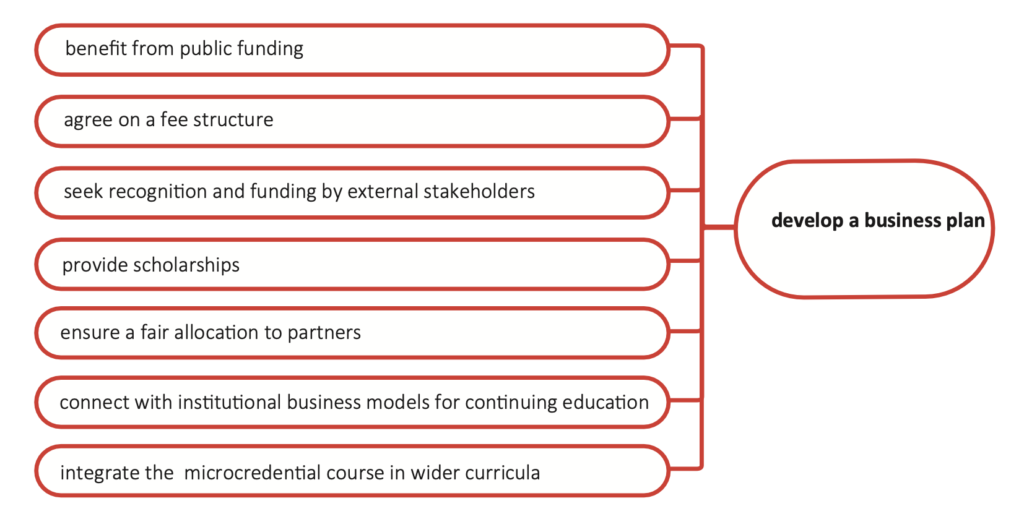
| The course team has to develop a business plan for the joint micro-credential course, which is depending on a set of parameters |
| Benefit from public funding; |
| Agree on a fee structure; |
| Seek recognition and funding by external stakeholders; |
| Provide scholarships; |
| Ensure a fair allocation to partners; |
| Connect with institutional business models for continuing education; |
| Integrate the micro-credential course in a wider curriculum. |
Guidelines
Benefit from public funding
National funding of micro-credential courses and programmes can vary widely from country to country. In some countries, these programmes are not recognized for funding. Recognition would ensure that they can be funded as parts of continuing education.
Project funding is supportive, but not sufficient to ensure the long-term sustainability of a micro-credential course.
In a start-up phase, a micro-credential course can eventually be funded by European programmes such as Erasmus+, for example, Sectoral Alliance on Skills (See: https://ec.europa.eu/programmes/erasmus-plus/programme-guide/part-b/key-action-2/partnerships-cooperation/alliances-innovation_en ) or the European Social Fund (see the national ESF agencies).
Most importantly, the development of joint micro-credential courses and programmes is funded under the European Universities Initiative (EUI), through which alliances develop innovative educational formats for blended or online continuing education.
Agree on a fee structure
The partners jointly determine a registration fee for the micro-credential course. Ultimately, they can differentiate this fee for individual and collective subscriptions. They must ensure that individual fees are affordable for learners.
A complicating factor is that higher education tuition fees generally vary from country to country and in some countries even tuition fees are not paid.
When determining fees, partners must balance the fees in different national systems and other public and private revenue streams on the one hand, and the operational costs of the course on the other.
They may consider that online courses are more scalable and therefore the marginal cost per student may be lower, which may affect the fee structure for the course.
Seek recognition and funding by external stakeholders
In some areas relevant to employment and innovation, partners can spark the interest of external stakeholders such as companies, business sectors or professional organizations to recognize and support a micro-credential course, for example through sectoral funds.
In some countries, personal learning accounts are created that support learners to participate in continuing education courses.
Provide scholarships
In the case of high enrollment fees, joint micro-credential courses may provide scholarships to individual students sponsored by companies or other stakeholders.
Ensure a fair allocation to partners
In public funding, partners are bound by national regulations. When developing business models, fees and private funding streams can be allocated to partners based on their actual contribution to the course.
Connect with institutional business models for continuing education
Joint micro-credential courses are an integral part of an institution’s continuing education provisions. At the same time, they are co-owned by each individual partner university.
Therefore, within this common framework, they should be managed as a separate entity in each institution. In order to promote innovation, the revenue streams for micro-credential courses should be allocated directly to the faculty and to the joint course team.
Institutional business models for continuing education might mirror those for innovation and knowledge transfer.
Integrate the micro-credential course in a wider curriculum
Universities can also valorize micro-credential courses in wider micro-credential programmes or in bachelor or master degree programmes. As such, they can also be presented to other universities for mobility.
next chapter: Develop a recruitment plan
previous chapter: Assure quality
back to overview: Models and guidelines for the design and development of
joint micro-credential courses and microlearning units in higher education
